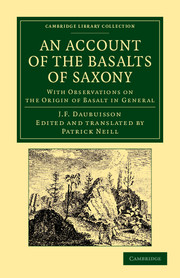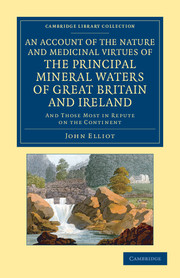Refine search
Actions for selected content:
10306 results in History of science: general interest
Robert G.W. Kirk and Neil Pemberton, Leech. London: Reaktion Books, 2013. Pp. 208. ISBN 978-1-78023-033-7. £9.99 (paperback).
-
- Journal:
- The British Journal for the History of Science / Volume 47 / Issue 1 / March 2014
- Published online by Cambridge University Press:
- 14 February 2014, pp. 173-175
- Print publication:
- March 2014
-
- Article
- Export citation
Vera M. Kutzinski, Ottmar Ette and Laura Dassow Walls (eds.), Alexander von Humboldt and the Americas. Berlin: Verlag Walter Frey, 2012. Pp. 295. ISBN 978-3-938944-63-9. €19.80 (paperback)
-
- Journal:
- The British Journal for the History of Science / Volume 47 / Issue 1 / March 2014
- Published online by Cambridge University Press:
- 14 February 2014, pp. 185-187
- Print publication:
- March 2014
-
- Article
- Export citation
Germano Maifreda, From Oikonomia to Political Economy: Constructing Economic Knowledge from the Renaissance to the Scientific Revolution. Farnham: Ashgate, 2012. Pp. vii+304. ISBN 978-1-4094-3301-9. £70.00 (hardback).
-
- Journal:
- The British Journal for the History of Science / Volume 47 / Issue 1 / March 2014
- Published online by Cambridge University Press:
- 14 February 2014, pp. 179-181
- Print publication:
- March 2014
-
- Article
- Export citation
Catherine Packham, Eighteenth-Century Vitalism: Bodies, Culture, Politics. Basingstoke: Palgrave Macmillan, 2012. Pp. viii+250. ISBN 978-0-230-27618-5. £50.00 (hardback)
-
- Journal:
- The British Journal for the History of Science / Volume 47 / Issue 1 / March 2014
- Published online by Cambridge University Press:
- 14 February 2014, pp. 182-183
- Print publication:
- March 2014
-
- Article
- Export citation
Roger S. Wotton, Walking with Gosse: Natural History, Creation, and Religious Conflicts. Southampton: Clio Publishing, 2012. Pp. viii+214. ISBN 978-0-9556983-9-2. £11.95 (paperback).
-
- Journal:
- The British Journal for the History of Science / Volume 47 / Issue 1 / March 2014
- Published online by Cambridge University Press:
- 14 February 2014, pp. 187-188
- Print publication:
- March 2014
-
- Article
- Export citation
Alison D. Morrison-Low, Sven Dupré, Stephen Johnston and Giorgio Strano (eds.), From Earth-Bound to Satellite: Telescopes, Skills and Networks. Leiden: Brill, 2012. Pp. xlvi+265. ISBN 978-90-04-21150-6. €99.00 (hardback).
-
- Journal:
- The British Journal for the History of Science / Volume 47 / Issue 1 / March 2014
- Published online by Cambridge University Press:
- 14 February 2014, pp. 181-182
- Print publication:
- March 2014
-
- Article
- Export citation
Nathaniel Comfort, The Science of Human Perfection: How Genes Became the Heart of American Medicine. New Haven and London: Yale University Press, 2012. Pp. xvii+316. ISBN 978-0-300-16991-1. £25.00 (hardback).
-
- Journal:
- The British Journal for the History of Science / Volume 47 / Issue 1 / March 2014
- Published online by Cambridge University Press:
- 14 February 2014, pp. 191-192
- Print publication:
- March 2014
-
- Article
- Export citation
‘We want no authors’: William Nicholson and the contested role of the scientific journal in Britain, 1797–1813†
-
- Journal:
- The British Journal for the History of Science / Volume 47 / Issue 3 / September 2014
- Published online by Cambridge University Press:
- 11 February 2014, pp. 397-419
- Print publication:
- September 2014
-
- Article
- Export citation

An Account of the Basalts of Saxony
- With Observations on the Origin of Basalt in General
-
- Published online:
- 05 January 2014
- Print publication:
- 05 September 2013
- First published in:
- 1814
‘What things mean in our daily lives’: a history of museum curating and visiting in the Science Museum's Children's Gallery from c.1929 to 1969
-
- Journal:
- The British Journal for the History of Science / Volume 47 / Issue 3 / September 2014
- Published online by Cambridge University Press:
- 18 December 2013, pp. 505-538
- Print publication:
- September 2014
-
- Article
- Export citation

An Account of the Nature and Medicinal Virtues of the Principal Mineral Waters of Great Britain and Ireland
- And Those Most in Repute on the Continent
-
- Published online:
- 18 December 2013
- Print publication:
- 29 August 2013
- First published in:
- 1789
Speculations on the perceptive Power of Vegetables
-
- Book:
- The Works, Literary, Moral, and Medical, of Thomas Percival, M.D.
- Published online:
- 05 October 2014
- Print publication:
- 21 November 2013, pp 231-248
-
- Chapter
- Export citation
CHAPTER IV - OF PROFESSIONAL DUTIES, IN CERTAIN CASES WHICH REQUIRE A KNOWLEDGE OF LAW
- from MEDICAL ETHICS; or, a Code of Institutes and Precepts, adapted to the professional Conduct of Physicians and Surgeons
-
- Book:
- The Works, Literary, Moral, and Medical, of Thomas Percival, M.D.
- Published online:
- 05 October 2014
- Print publication:
- 21 November 2013, pp 416-460
-
- Chapter
- Export citation
Observations and Experiments on the Poison of Lead
-
- Book:
- The Works, Literary, Moral, and Medical, of Thomas Percival, M.D.
- Published online:
- 05 October 2014
- Print publication:
- 21 November 2013, pp 449-475
-
- Chapter
- Export citation
On the Preparation, Culture, and Use of the Orchis Root
-
- Book:
- The Works, Literary, Moral, and Medical, of Thomas Percival, M.D.
- Published online:
- 05 October 2014
- Print publication:
- 21 November 2013, pp 285-294
-
- Chapter
- Export citation
PART THE SECOND
-
- Book:
- The Works, Literary, Moral, and Medical, of Thomas Percival, M.D.
- Published online:
- 05 October 2014
- Print publication:
- 21 November 2013, pp 93-248
-
- Chapter
- Export citation
Socratic Discourse on Truth
-
- Book:
- The Works, Literary, Moral, and Medical, of Thomas Percival, M.D.
- Published online:
- 05 October 2014
- Print publication:
- 21 November 2013, pp 1-68
-
- Chapter
- Export citation
Facts and Queries relative to Attraction and Repulsion
-
- Book:
- The Works, Literary, Moral, and Medical, of Thomas Percival, M.D.
- Published online:
- 05 October 2014
- Print publication:
- 21 November 2013, pp 249-259
-
- Chapter
- Export citation
On the Advantages of a Taste for the general Beauties of Nature and of Art
-
- Book:
- The Works, Literary, Moral, and Medical, of Thomas Percival, M.D.
- Published online:
- 05 October 2014
- Print publication:
- 21 November 2013, pp 125-138
-
- Chapter
- Export citation
MEDICAL ETHICS; or, a Code of Institutes and Precepts, adapted to the professional Conduct of Physicians and Surgeons
-
- Book:
- The Works, Literary, Moral, and Medical, of Thomas Percival, M.D.
- Published online:
- 05 October 2014
- Print publication:
- 21 November 2013, pp 355-358
-
- Chapter
- Export citation
